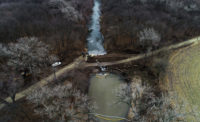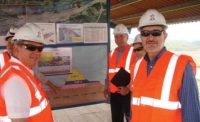Crude oil gushed for nearly 15 years from collapsed wells in the Gulf of Mexico after the Saratoga production platform, with 28 working wells, was toppled by Hurricane Ivan in 2004. By April 2019, when the discharge was contained by an innovative system designed by Couvillion Group LLC, it had earned distinction as the longest offshore oil spill in U.S. history, polluting the Gulf with as much as 107 barrels of crude oil per day.
Taylor Energy Co. LLC, the platform’s owner, went out of business in 2008 but remained responsible under federal law to plug and abandon wells on the 450-ft-deep seabed. Claiming the flow was no more than a few gallons per day, Taylor slow-walked its response and resisted action, U.S. Coast Guard officials say. In October 2018, after years of pushing Taylor to complete the work, the Coast Guard partially assumed response actions, sought proposals to contain the discharge and selected Couvillion from among eight responses.
The Coast Guard called for urgent action; Couvillion engineers brainstormed containment designs and settled on one. “We had four different engineering firms producing drawings, and then I would bid it out [one component at a time],” CEO Timmy Couvillion says. “We wound up having five different fabricators fabricating at six different locations, so the fit test became incredibly important, and our quality assurance and quality control became paramount.”
Last April 16, Couvillion installed a shallow 200-ton steel box on the sea floor—3 ft high, 40 ft by 40 ft, with a 10-ft by 20-ft extension—to cover the 17-ft by 54-ft area of the discharge. In a federal court status report in May, the Coast Guard said that the containment system “is now fully installed and operating as planned.” By Nov. 10, the system had collected more than 6,000 barrels of oil and delivered it to shore for sale.
Couvillion, 45, who is from Plaquemines Parish, has a native’s passion for the outdoors, the Gulf waters he grew up on and the marine life they hold. He also has a practical appreciation of the oil-and-gas industry and the careful balance between the two.
While studying for his mechanical engineering degree at the University of New Orleans, he captained a charter boat for Oceaneering International, taking its customers fishing. His Oceaneering contacts were impressed by the depth of his ability to take in the bigger picture from both an environmental and engineering perspective. The company hired him when he graduated in 2004. After a year as a project manager, he founded Couvillion Group in 2005 to provide marine services for the oil and gas sector.
When Hurricane Katrina struck New Orleans that year, the company was a key first responder in the Plaquemines Parish vessel recovery effort. Couvillion designed a unique lift and barge system that returned hundreds of vessels to service. After the catastrophic BP oil spill linked to the Deepwater Horizon platform explosion in 2010, the Couvillion Group supported the extended cleanup effort.






Post a comment to this article
Report Abusive Comment